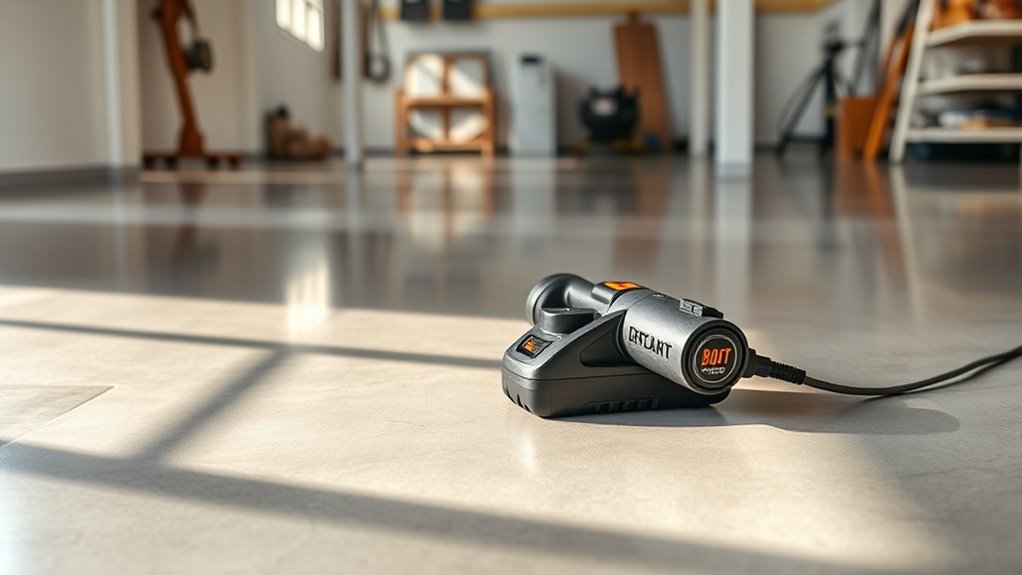To maximize battery runtime and extend its life during polished concrete maintenance, it’s important to understand your battery type, use proper charging techniques, and perform regular inspections. Avoid deep discharges, store batteries in cool, dry places, and use compatible chargers to prevent overcharging. Keep terminals clean and monitor performance with routine tests. If you want to learn more tips on maintaining batteries for longer-lasting power, there’s plenty to explore.
Key Takeaways
- Regularly inspect and clean battery terminals to prevent corrosion and ensure optimal conductivity.
- Use manufacturer-recommended chargers and avoid overcharging to prolong battery lifespan.
- Store batteries in cool, dry environments at 40-60% charge to prevent capacity loss.
- Monitor battery voltage and temperature frequently to detect early signs of weakening.
- Avoid deep discharges by recharging at 20-30% capacity for better performance and longevity.
Understanding Battery Types Commonly Used on Polished Concrete Floors

To effectively care for polished concrete floors, it’s important to understand the battery types used in equipment that maintains them. The most common batteries are lead-acid and lithium-ion. Lead-acid batteries are affordable and reliable, often found in older equipment. They require regular maintenance, like checking fluid levels, to keep them performing well. Lithium-ion batteries, on the other hand, are lighter, have higher energy density, and require less maintenance. They charge faster and last longer between charges. Knowing which type your equipment uses helps you manage its performance better. Lithium-ion batteries are becoming more popular due to their efficiency, but lead-acid batteries still remain common in many maintenance tools. Recognizing these differences allows you to optimize your equipment’s operation and prolong its lifespan. For optimal performance, understanding the source and manufacturing processes of your batteries can further enhance their longevity.
Proper Charging Techniques to Maximize Battery Life
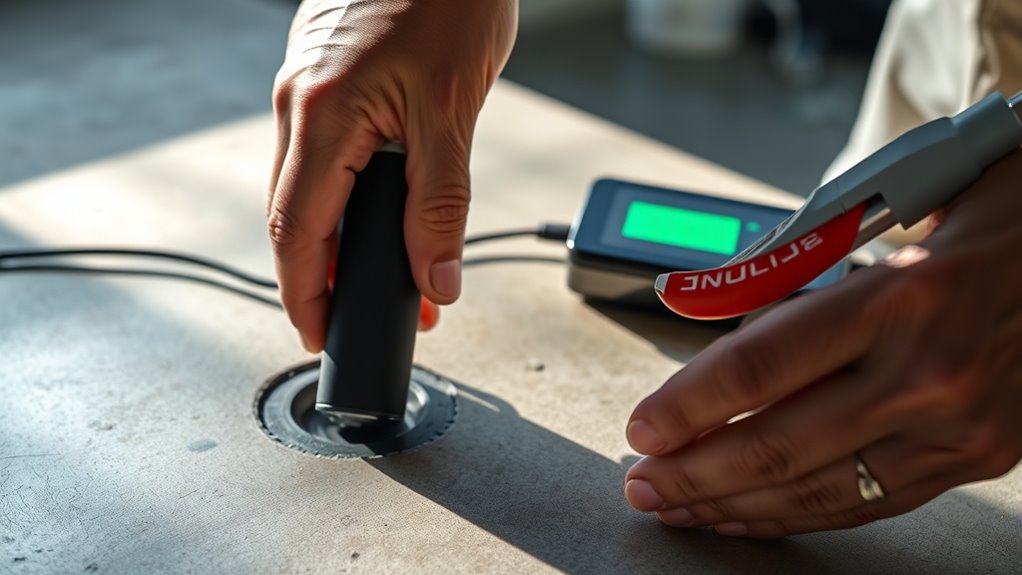
Proper charging techniques play a key role in extending the lifespan and maintaining the performance of your batteries. To get the most out of your batteries, follow these tips:
- Charge the battery fully before use to ensure maximum capacity.
- Avoid letting the battery discharge completely; recharge when it hits about 20-30%.
- Use the correct charger specified for your battery type to prevent damage.
- Don’t leave batteries on charge longer than recommended to avoid overcharging and overheating.
- Regular calibration of the battery can help in maintaining accurate charge indicators and prolong overall battery health battery calibration techniques.
Regular Inspection and Maintenance of Battery Terminals
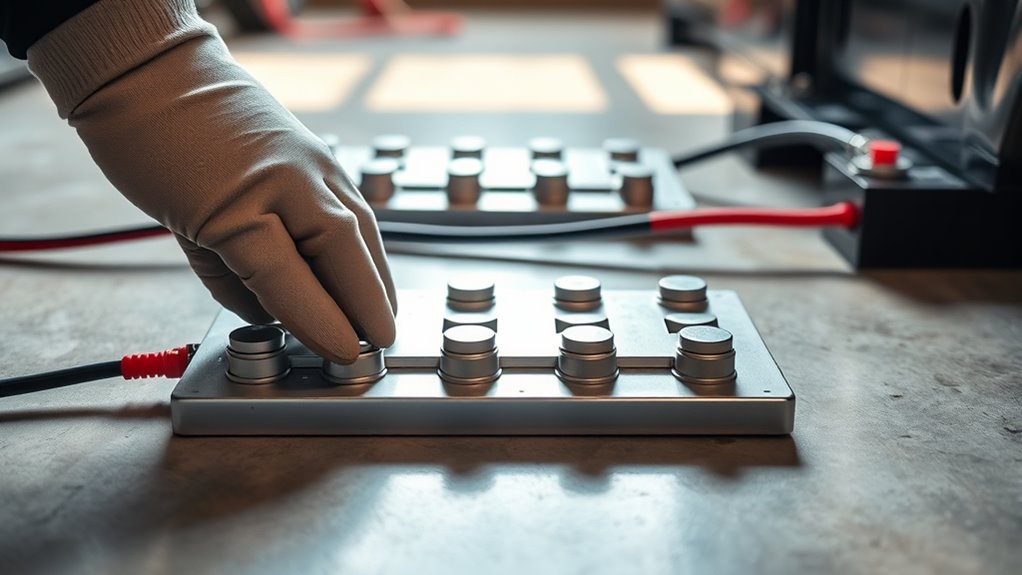
Regularly inspecting your battery terminals helps prevent issues before they start. Look for signs of corrosion, make sure connections are tight, and consider applying protective coatings to extend their lifespan. Staying on top of these tasks keeps your battery running smoothly and reduces maintenance surprises.
Terminal Corrosion Signs
Since battery terminals are exposed to moisture and dirt, they often show signs of corrosion over time. Recognizing these signs helps you prevent performance issues. Look out for:
- White or bluish powdery residue around the terminals
- Greenish or bluish corrosion buildup on metal surfaces
- Loose or wobbly connections when you try to tighten them
- Reduced battery performance, like slower charging or shorter runtime
Regularly checking corrosion signs and maintaining the terminals can significantly extend your battery’s lifespan. If you notice any of these signs, it’s time to clean the terminals and inspect for damage. Corrosion can impede electrical flow, leading to premature battery failure. Regularly inspecting your terminals guarantees you catch corrosion early, keeping your setup running smoothly and extending your battery’s lifespan.
Tighten Connections Regularly
When you notice signs of corrosion on your battery terminals, it’s important to check the connections for looseness. Loose terminals can cause poor electrical contact, leading to decreased performance and faster battery drain. Regularly inspect your battery connections to verify they’re tight and secure. Use a wrench to gently tighten any loose terminals, but avoid overtightening, which can damage the battery post or terminal. Tight connections improve conductivity and help prevent corrosion from building up due to micro-movements. Properly tightened terminals ensure a reliable connection, maximizing your battery’s efficiency and lifespan while supporting longer runtime for your polished concrete projects. Additionally, corrosion prevention techniques can help maintain clean and secure connections over time.
Apply Protective Coatings
Applying protective coatings to your battery terminals is a key step in preventing corrosion and ensuring reliable electrical connections. A good coating creates a barrier that shields terminals from moisture and dirt. To do this effectively:
- Clean the terminals thoroughly with a wire brush or terminal cleaner.
- Dry the area completely to prevent trapping moisture.
- Apply a thin layer of protective coating, like dielectric grease or terminal spray.
- Reconnect and tighten the terminals securely.
Regularly inspecting and reapplying the coating keeps corrosion at bay and maintains ideal performance. This simple routine extends your battery’s life and improves its runtime. Keep your polished concrete surface clean and dry to avoid debris buildup that can compromise the coating’s effectiveness. Proper maintenance now saves you from costly replacements later.
Additionally, understanding AI vulnerabilities can help develop smarter safety measures for battery management systems, enhancing their resilience against potential failures.
Optimal Storage Practices When Batteries Are Not in Use
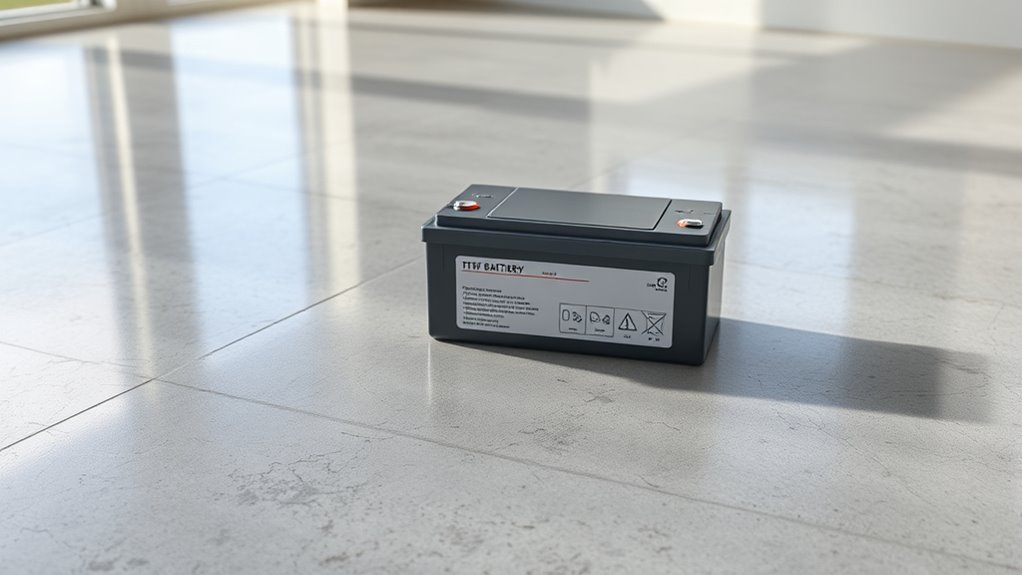
To guarantee your batteries remain in ideal condition during periods of non-use, you should store them in a cool, dry environment away from direct sunlight and extreme temperatures. Store batteries at a partial charge, around 40-60%, to prevent capacity loss caused by over-discharge or overcharging. Keep terminals clean and protected from corrosion by placing batteries in anti-static bags or insulating them with non-conductive materials. Avoid storing batteries near metal objects that could cause short circuits. Ensure the storage area is well-ventilated to prevent heat buildup. Regularly check batteries for signs of damage or leakage, and recharge them to the recommended level if stored for extended periods. Proper storage preserves battery health, ensuring longer runtime and a longer overall lifespan. Monitoring battery health regularly can help identify potential issues early and extend the life of your batteries.
Environmental Factors Affecting Battery Performance
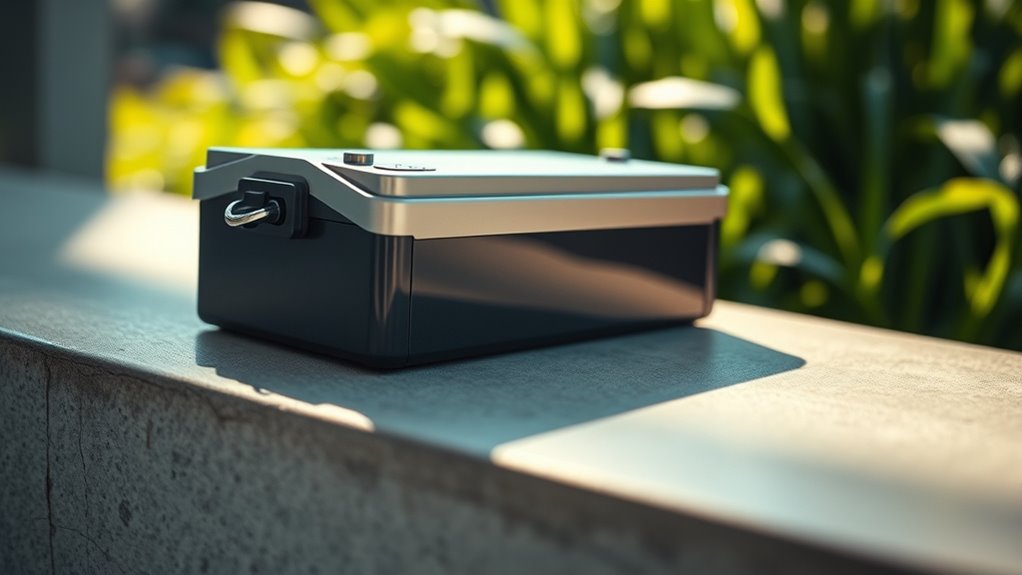
Environmental factors such as temperature, humidity, and exposure to sunlight directly influence your battery’s performance and lifespan. High temperatures can cause batteries to overheat, reducing their capacity and accelerating wear. Humidity introduces moisture that can lead to corrosion and internal damage. Direct sunlight increases temperature and can degrade battery components over time. To protect your battery, consider these tips:
- Store batteries in a cool, dry place away from direct sunlight.
- Maintain a stable temperature, ideally between 50°F and 77°F (10°C-25°C).
- Avoid exposing batteries to excessive humidity or moisture.
- Regularly check storage conditions to ensure consistent environmental control.
- Proper insulation and ventilation can help mitigate the effects of temperature fluctuations on your battery heat management technology.
Identifying Signs of Battery Wear and When to Replace
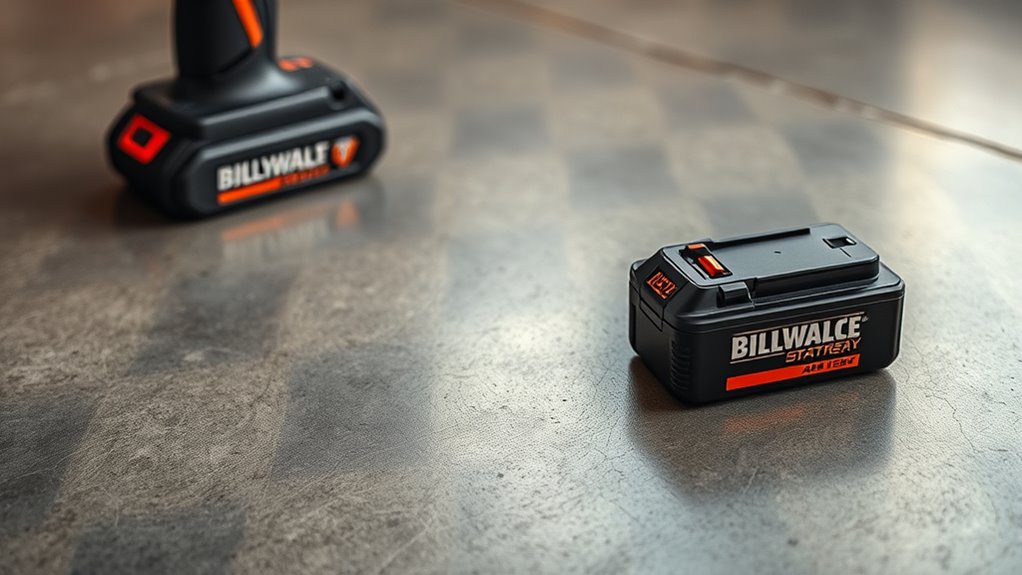
Over time, even with proper storage and environmental controls, batteries naturally wear out and lose their effectiveness. You’ll notice reduced runtime during use, as your battery can’t hold a full charge like it used to. If your equipment takes longer to power up or if it shuts down unexpectedly, these are clear signs your battery is weakening. Swelling, corrosion, or leakage are physical indicators that a replacement is overdue. Additionally, if your battery no longer reaches its full charge or drains quickly after charging, it’s a sign it’s nearing the end of its lifespan. Recognizing these signs early helps you avoid unexpected downtime and protects your equipment from damage. When these symptoms persist, it’s time to replace the battery to maintain ideal performance. Being aware of battery failure warning signs can help you plan for timely replacements and extend the overall life of your equipment.
Using Compatible Chargers and Avoiding Overcharging
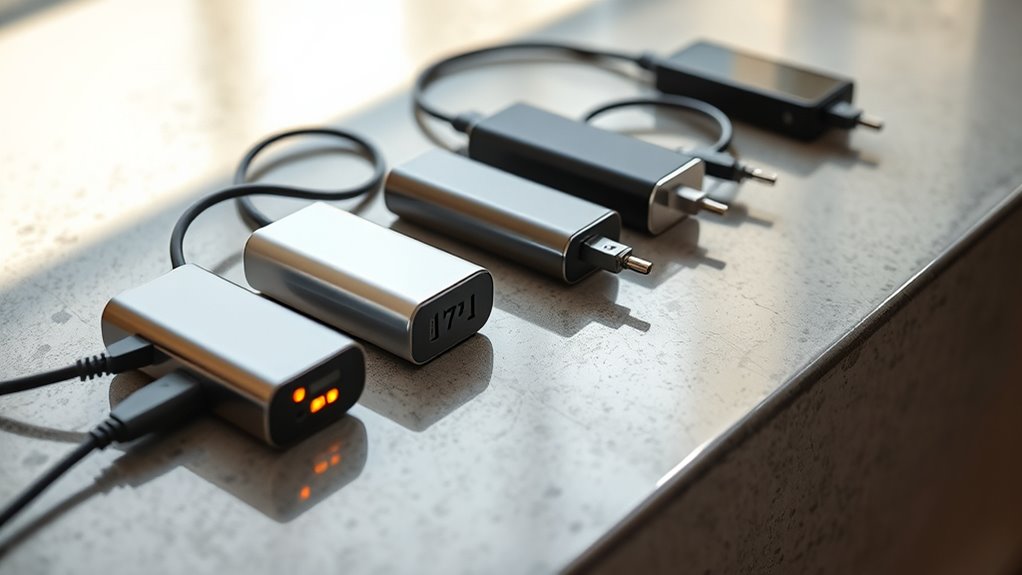
Using compatible chargers is essential to guarantee your battery’s safety and longevity. When you use the right charger, you prevent damaging voltage or current that could shorten your battery’s lifespan. To avoid overcharging, follow these tips:
Using compatible chargers ensures battery safety and longevity by preventing damaging voltage and overcharging.
- Always use chargers recommended by the manufacturer.
- Set charging limits to prevent continuous charging after full capacity.
- Disconnect the charger as soon as the battery is full.
- Regularly inspect the charger and cables for damage or wear.
Overcharging causes excessive heat and stress, which can degrade the battery’s internal components. By sticking to compatible chargers and stopping the charge at the right moment, you extend your battery’s runtime and overall life. Proper charging practices are simple but critical for maintaining ideal performance.
Implementing Routine Battery Testing and Monitoring
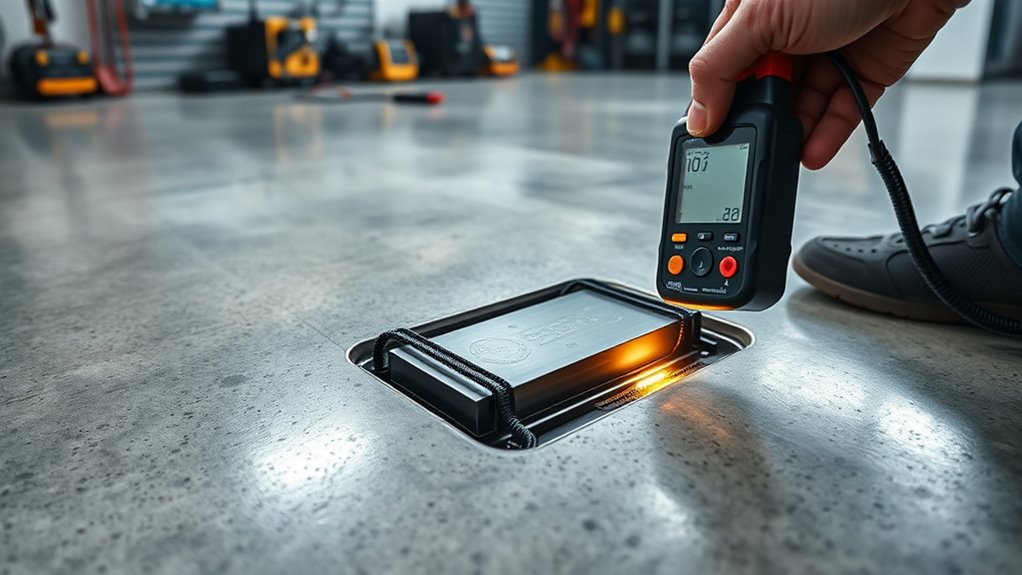
You need to regularly check your battery’s voltage to catch issues early. Monitoring charge cycles helps you understand how the battery is aging, while tracking temperature variations prevents overheating risks. Consistent testing guarantees your polished concrete setup stays reliable and efficient. To optimize your setup, consider integrating a portable power source that matches your energy demands and ensures safety.
Regular Voltage Checks
Regular voltage checks are essential for maintaining peak battery performance and preventing unexpected failures. By regularly measuring your battery’s voltage, you can catch issues early and take action before problems escalate. Here’s what you should do:
- Check the voltage at the start and end of each shift to track performance.
- Use a reliable multimeter to guarantee accurate readings.
- Record each measurement for trend analysis.
- Replace or service batteries showing consistently low voltage levels.
- Incorporate battery maintenance to optimize longevity and performance.
Consistent voltage monitoring helps you identify declining batteries that could cause downtime. It also allows you to schedule maintenance proactively, extending your battery’s lifespan and ensuring your polished concrete equipment runs smoothly. Don’t overlook this simple step; it’s crucial for reliable operation and longer battery life.
Monitor Charge Cycles
Implementing routine battery testing and monitoring of charge cycles is essential for identifying early signs of battery degradation. By tracking how many times your battery charges and discharges, you can gauge its overall health and predict when it might need replacement. Keep detailed records of each cycle, noting any irregularities or reduced capacity. Using a battery management system or specialized software simplifies this process, providing real-time data and alerts. Monitoring charge cycles helps you avoid overuse, which can shorten battery life, and guarantees you maintain ideal performance. Regularly checking this data allows you to schedule maintenance proactively, preventing unexpected downtime. Staying aware of your battery’s cycle count ultimately extends its lifespan and ensures longer runtime for your polished concrete equipment.
Track Temperature Variations
Monitoring charge cycles helps identify early signs of battery wear, but temperature variations can also reveal underlying issues that affect performance. Fluctuations outside normal ranges may indicate problems like overcharging, overheating, or aging cells. Regularly tracking temperature helps catch issues early, preventing failure. Here’s what you should do:
- Use a thermal sensor to monitor battery temperatures during operation.
- Record temperature readings consistently to identify trends.
- Compare temperatures across different cycles for anomalies.
- Adjust usage or maintenance if temperatures regularly spike or drop unexpectedly.
Tips for Extending Overall Battery Longevity
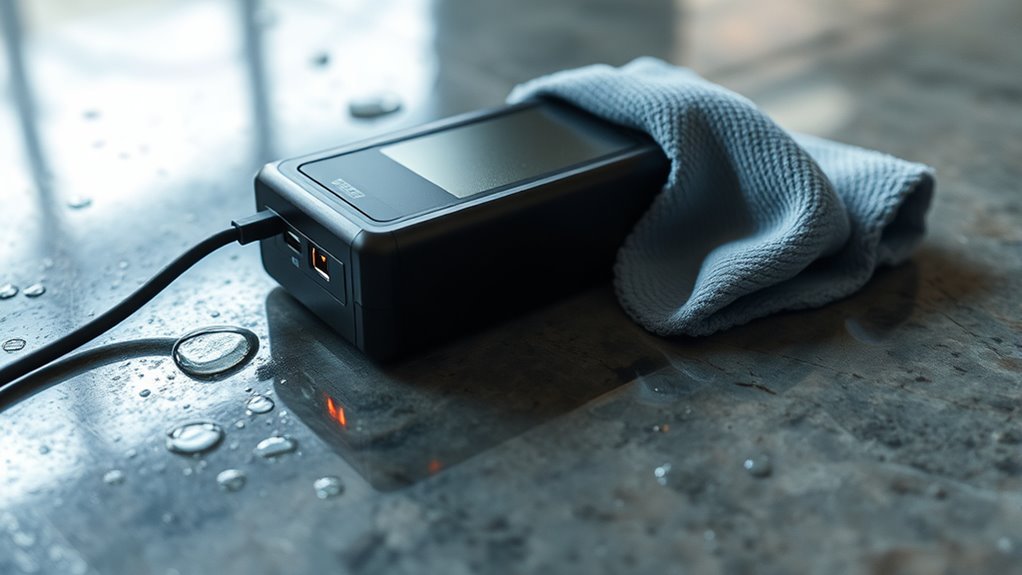
To maximize your battery’s lifespan, it’s essential to adopt proper charging and usage habits. Always avoid letting the battery fully discharge; instead, recharge it when it reaches around 20-30%. Use the correct charger recommended by the manufacturer to prevent overcharging or electrical damage. Keep your battery in a cool, dry place when not in use, as excessive heat accelerates wear. Don’t leave it plugged in continuously after reaching full charge—unplug it to prevent stress on the cells. Regularly calibrate your battery by performing a full charge and discharge cycle every few months. Finally, limit exposure to extreme temperatures during use and storage. These habits will help extend your battery’s overall longevity, ensuring longer runtime and better performance over time.
Frequently Asked Questions
What Safety Precautions Should Be Taken During Battery Maintenance?
You should always wear protective gear like gloves and safety goggles to prevent contact with harmful chemicals. Make sure to work in a well-ventilated area and disconnect the battery before maintenance. Avoid sparks or open flames, as batteries can emit flammable gases. Handle batteries carefully to prevent leaks or damage, and follow manufacturer instructions closely. Properly dispose of old batteries to prevent environmental harm.
How Do Temperature Fluctuations Affect Battery Performance?
Temperature fluctuations can substantially impact your battery’s performance. When it’s too hot, your battery may overheat, causing reduced efficiency and potential damage over time. Cold temperatures slow down chemical reactions, decreasing runtime and capacity. To keep your battery performing well, store it in a stable environment, avoid extreme temperatures, and monitor conditions regularly. Proper temperature management helps extend your battery’s lifespan and ensures reliable operation.
Can Different Battery Brands Be Used Interchangeably?
Yes, you can typically use different battery brands interchangeably, but be cautious. Compatibility counts, so check the voltage, capacity, and connector type to make certain they fit your equipment perfectly. Don’t forget, using mismatched batteries might lead to poor performance or damage. To keep your tools running reliably, stick to reputable brands or those recommended by the manufacturer. Proper pairing promotes prolonged performance and prevents potential problems.
What Are the Environmental Regulations for Disposing of Old Batteries?
You need to follow local and federal regulations when disposing of old batteries. Typically, you should not throw them in regular trash because they contain hazardous materials. Instead, take them to designated recycling centers or authorized collection points. Proper disposal helps prevent environmental contamination and promotes safety. Always check your area’s specific rules, as regulations can vary, ensuring you dispose of batteries responsibly and in compliance with the law.
How Does Usage Frequency Influence Battery Lifespan?
Think of your battery as a delicate racehorse; the more you make it run, the faster it wears out. When you use it frequently, it experiences more charge cycles, which gradually diminish its lifespan. To keep it healthy, avoid unnecessary use and give it time to rest between runs. This way, you extend its runtime and ensure it stays reliable longer, much like nurturing a champion for future races.
Conclusion
By caring for your batteries, you guarantee longer runtime and a longer lifespan—like giving your polished concrete floors the treatment they deserve. Neglect, however, can lead to costly replacements and downtime, turning a simple maintenance task into a frustrating challenge. So, stay vigilant and proactive. After all, investing a little effort today can save you from bigger headaches tomorrow, proving that good battery care isn’t just about longevity—it’s about keeping your floors shining and your projects on track.
